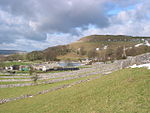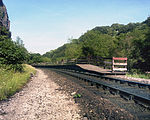Five Wells

Five Wells is a Neolithic chambered tomb between the villages of Chelmorton and Taddington on Taddington Moor in the Derbyshire Peak District in England. The tomb is a protected scheduled ancient monument. Three stones mark the main chamber, which has been dramatically reduced; a second less well-preserved chamber is to the west. The burial mound is over 20 metres (66 ft) in diameter and was first excavated by the local archaeologist Thomas Bateman in 1846. The chambers have paved floors. Bateman discovered the remains of at least twelve human skeletons. Subsequent excavations (by Llewellyn Jewitt, William Lukis and Micah Salt between 1862 and 1901) found further human remains, pottery and flint tools in the chambers and passages and a separate cist (stone coffin) within the mound.Access can be made on foot via a permitted path from Pillwell Gate to the west. Access along the permitted path can also be made from the Limestone Way long-distance footpath, which runs along Sough Lane 500 metres (550 yd) to the east.
Excerpt from the Wikipedia article Five Wells (License: CC BY-SA 3.0, Authors, Images).Five Wells
Senners Lane, Derbyshire Dales
Geographical coordinates (GPS) Address External links Nearby Places Show on map
Geographical coordinates (GPS)
| Latitude | Longitude |
|---|---|
| N 53.23626 ° | E -1.81595 ° |
Address
Five Wells
Senners Lane
SK17 9TH Derbyshire Dales
England, United Kingdom
Open on Google Maps











